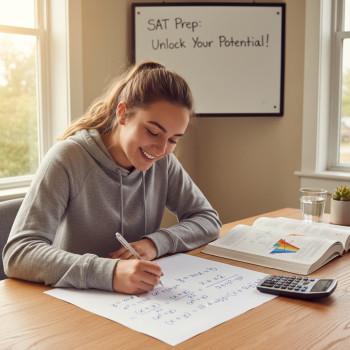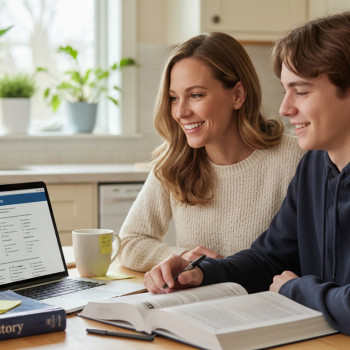Why technology is your best study partner for the Digital SAT
If you feel a little nervous about the Digital SAT, that’s completely normal. The good news? Technology isn’t the enemy — it’s the single most useful ally you can bring into your study routine. The modern SAT is shorter, adaptive, and delivered digitally, so learning to use tech well turns the format from a curveball into a clear advantage. This post walks you through practical, human-friendly ways to harness devices, apps, and data so you study smarter, not harder.
What “digital” really means for your preparation
Digital testing changes the environment — not the goal. You still need to show reading, writing, and math skills, but now you’ll experience an adaptive test environment, built-in tools, and a different pacing. Practicing on paper alone won’t prepare you for the look and feel of the test. Using official digital practice tools helps you get comfortable with on-screen navigation, highlighting tools, the built-in calculator, and how questions adapt as you go.
Build a tech-aware study plan that fits how you learn
Start by mapping the basics: how many weeks you have, which sections need the most attention, and what devices you’ll use on test day. Then fold technology into that plan — not as a distraction, but as structured support.
Step-by-step framework
- Assess your baseline: take an official full-length digital practice test to see where you are and identify weak spots.
- Set measurable goals: pick a target score for each section and a realistic timeline to improve by incremental points.
- Choose tools: decide on a mix of adaptive practice tests, focused question banks, and tutorial videos that match your needs.
- Schedule tech blocks: uninterrupted time for deep practice and short tech-driven review sessions (flashcards, micro-quizzes) for daily reinforcement.
- Review data regularly: use the feedback from practice tests and personalized platforms to adjust your plan each week.
Think of technology like a GPS for your studying — it tells you where you are, suggests alternate routes, and can reroute you if you get stuck. But you still need to drive; the tools aren’t a shortcut around focused work.
Must-use digital tools and how to use them effectively
Not all tech is created equal. Here’s a shortlist of the most practical categories of tools and how to squeeze the most value from each.
1) Official adaptive practice tests (practice like test day)
Full-length adaptive practice tests give you the truest simulation of the actual exam. Use them to:
- Practice time management under digital conditions.
- Experience adaptive difficulty and learn how to approach question clusters.
- Get official-style feedback that points to content gaps.
2) Targeted question banks and micro-practice
After a full test, narrow in on weak areas. Use question banks that let you filter by topic (e.g., algebra, expression of ideas, evidence-based reading) and difficulty. Short, frequent sessions with 10–20 questions are high-impact: they keep momentum, reduce fatigue, and build skill through repetition.
3) Video lessons and conceptual deep dives
When you hit a recurring error, don’t just memorize the right answer — watch or read a short lesson that explains the concept. A 10–15 minute video can convert repeated mistakes into lasting understanding.
4) Spaced-repetition flashcard apps
Vocabulary, grammar rules, formulas, and problem-solving heuristics stick better when reviewed at spaced intervals. Use an app that pushes the tougher items more often and the easier ones less — this is efficient memory work that takes only a few minutes a day.
5) Timers, focus apps, and distraction blockers
Studying with technology requires discipline. Tools like the Pomodoro timer, website blockers, or focus modes on phones give you structured focus windows and protect study time from social media creep. Treat focus blocks as sacred practice sessions; your brain learns best with concentrated effort and short breaks.
How to practice adaptive testing strategies
Adaptive tests respond to your answers by adjusting the difficulty of future questions. That changes strategy in a few important ways:
Read for accuracy, not speed
Because difficulty can increase after correct answers, accuracy matters more than reckless speed. Rushing increases the chance of hitting tougher questions you aren’t ready for. Instead, prioritize correct, confident answers and use practice to raise your comfortable speed.
Use strategic guessing
There’s no penalty for guessing on the SAT. When time is low, educated guesses are better than leaving blanks. Practice identifying high-probability answers (eliminate one or two choices quickly) so you can guess intelligently under time pressure.
Balance risk and reward
Adaptive tests can nudge you into tougher question sets. If you’re seeing a cluster of hard questions, pause and reassess: is the time investment on this item the best use of your remaining time? Practicing with adaptive tests will teach your instincts for when to persist and when to move on.
Using data to guide your study — not overwhelm it
One of technology’s biggest gifts is data: item-level feedback, timing breakdowns, and skill reports. But data can also become noise if you don’t prioritize the right signals.
Which metrics matter most
- Section-level accuracy (Reading & Writing, Math) — tells you broad strengths and weaknesses.
- Timing per question type — shows where you should practice pacing.
- Item difficulty performance — reveals whether mistakes are conceptual or careless.
- Score trajectory over several tests — indicates sustainable improvement or plateaus.
How to act on data
After each practice test, focus on two things: one skill to strengthen and one timing habit to improve. For example, if you miss algebraic manipulation questions and take too long on grid-in items, schedule focused algebra sessions and timed grid-in drills the following week. Small, targeted changes compound quickly.
Practical daily and weekly routines with tech
Here’s a sample 8-week routine that blends tech tools with focused study habits. Adapt it to your timeline and starting score.
| Week | Main Focus | Tech Tools | Daily Time |
|---|---|---|---|
| 1 | Baseline & Plan | Full-length digital practice test, score report | 2–3 hours |
| 2–3 | Core skill building (math fundamentals, reading strategies) | Targeted question bank, videos, flashcards | 1–2 hours |
| 4 | Timed practice & pacing | Section-timed quizzes, focus apps | 1–2 hours |
| 5–6 | Advanced problem solving & mixed sets | Adaptive practice tests, mixed bundles | 2–3 hours |
| 7 | Practice test & analysis | Full-length Bluebook test, deep item review | 3–4 hours |
| 8 | Polish & confidence | Light practice, flashcards, sleep & review | 1 hour |
This schedule blends longer, immersive practice sessions with shorter daily touchpoints that keep skills warmed up. The aim is steady progress, not frantic cramming.
How to combine human support with tech: the best of both worlds
Technology gives data and practice opportunities; human tutors provide nuance, motivation, and personal feedback. If you can pair both, you’ll accelerate faster than with either alone.
When to bring in a tutor or 1-on-1 coach
- When you repeatedly miss the same concepts despite practicing.
- When you need a tailored study plan, accountability, and strategy coaching.
- When time is limited and you need efficient, high-leverage improvements.
Personalized tutoring (for example, Sparkl’s 1-on-1 guidance) can translate your practice data into action: an expert tutor can spot subtle error patterns, adapt lesson plans to your pace, and suggest the right digital exercises. An effective tutoring relationship doesn’t replace practice; it makes your practice ruthlessly efficient.
Smart tech habits that separate progress from procrastination
Using tech well is as much about habit as it is about tools. Here are practical habits that students who improve consistently tend to share.
Top daily habits
- Warm up with 10–20 minutes of micro-practice (vocab, grammar, or mental math).
- Do one focused study block (45–90 minutes) without interruptions.
- End with a 10-minute review of errors from earlier practice — read why you missed them.
- Record one measurable takeaway each day: a rule, a quicker approach, or a corrected misconception.
Weekly rituals
- Take at least one timed section or a short adaptive quiz to check pacing.
- Review your practice-test report to update your study plan.
- Meet with a tutor or accountability partner to discuss strategy and emotional state.
Common pitfalls and how to avoid them
Technology can both help and distract. Here are traps to watch out for and straightforward fixes.
Pitfall: endless resource-hopping
Solution: pick a few high-quality tools and stick to them. Depth beats breadth. If you rotate through too many resources, you won’t build mastery or track progress effectively.
Pitfall: obsession with tiny metrics
Solution: focus on the 2–3 data points that matter for your goals (accuracy in a weak topic, time per question, and overall score trend). Ignore vanity stats that don’t translate into improvement.
Pitfall: practicing without review
Solution: always review mistakes. The highest-leverage minute of practice is the one you spend analyzing why you missed a question and how to prevent it next time.
Real-world examples: how students used tech to boost scores
Example 1: Maya went from a practice score in the low 1200s to 1400 in eight weeks. Her strategy: one full-length adaptive test every two weeks, daily 20-minute micro-practice sessions, and weekly video lessons for weak math topics. She tracked time per question and focused on cutting 20–30 seconds off average math items.
Example 2: Jamal improved reading comprehension by focusing on active reading practice delivered digitally. He used targeted question sets and a tutor to refine annotation habits. The tutor helped him practice summarizing passages aloud and choosing evidence quickly, which translated to better speed and accuracy.
Both students used technology for structured practice, then used human feedback — peers or a tutor — to refine strategies and stay motivated.
Checklist: preparing your tech setup for test day
Before test day, make sure your digital comfort is as routine as tying your shoes. Here’s a short checklist to run through weeks before the exam:
- Practice with the same type of device you’ll use on test day.
- Familiarize yourself with the digital testing app’s tools (highlighting, flagging, calculator, navigation).
- Charge devices and have a backup charger for practice sessions — build the habit of starting with full battery.
- Practice with the on-screen calculator until it feels natural.
- Run at least two full-length practice tests in a single day with breaks that mirror test-day timing.
How Sparkl-style personalized tutoring can accelerate tech-driven prep
While well-chosen tech can guide practice, a tutor helps translate data into action. Personalized tutoring adds three key benefits: real-time correction of recurring errors, study plans tailored to your digital test profile, and motivational accountability. A tutor who understands digital testing can recommend which practice tests to take, which adaptive features to exploit, and how to interpret the score reports so every hour of study moves the needle.
What to expect from good 1-on-1 tutoring alongside tech
- A tailored plan based on your initial diagnostic and practice-test analytics.
- Homework assignments that use official digital practice tools and targeted question sets.
- Coaching on digital test strategies like pacing, using the built-in tools, and when to guess.
- Feedback loops that convert mistakes into permanent improvements.
Final thoughts: make tech work for your brain, not against it
The Digital SAT rewards consistent effort and smart practice. Technology brings precision and personalization to your preparation, but it’s only powerful when paired with disciplined habits and occasional human guidance. Use official practice tests to simulate test day, supplement daily with micro-practice and spaced review, and bring in a tutor for targeted strategy and motivation when you need it. That combination — thoughtful tech use, focused study, and tailored support — is the fastest path from anxious to confident on test day.
Short parting checklist
- Take an official digital practice test to set your baseline.
- Choose one primary practice platform and one question bank to avoid fragmentation.
- Use daily micro-practice and weekly full-length adaptive tests to build rhythm.
- Use data to pick two priorities for each week: one skill and one timing habit.
- Consider 1-on-1 tutoring for personalized plans, feedback, and accountability.
Study smart, trust the data, and remember: progress rarely looks dramatic day-to-day, but small improvements add up fast. Take one step today — schedule a practice test, open a question set, or book a short tutoring session — and you’ll already be ahead. Good luck; you’ve got this.

















No Comments
Leave a comment Cancel